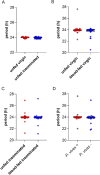Evaluation of insemination, blood feeding, and Plasmodium vivax infection effects on locomotor activity patterns of the malaria vector Anopheles darlingi (Diptera: Culicidae)
- PMID: 38060049
- PMCID: PMC10703739
- DOI: 10.1007/s00436-023-08053-5
Evaluation of insemination, blood feeding, and Plasmodium vivax infection effects on locomotor activity patterns of the malaria vector Anopheles darlingi (Diptera: Culicidae)
Abstract
Circadian behavioral patterns in mosquitoes can be observed through their locomotor activity, which includes fundamental behaviors such as foraging, mating, and oviposition. These habits, which are fundamental to the life cycle of Anopheles mosquitoes, are closely related to pathogen transmission to humans. While rhythmic cycles of locomotor activity have been described in Anopheles species, no studies have been conducted on Anopheles darlingi species, the main malaria vector in the Amazon region. The aim of this study was to investigate how insemination status, blood meal, and Plasmodium vivax infection affect the locomotor activity of An. darlingi. The experiments were performed with 3- to 10-day-old An. darlingi females, which had been fed with 15% honey solution. These mosquitoes were obtained from the Malaria Vector Production and Infection Platform (PIVEM)/FIOCRUZ-RO. The experimental groups were divided into four categories: virgin vs. inseminated, unfed virgin vs. blood-fed virgin, unfed inseminated vs. blood-fed inseminated, and infected blood vs. uninfected blood. Locomotor activity was monitored using the Flybox equipment, capturing images that were subsequently converted into video to measure the insect activity, using PySoLo software. The periodicity and rhythmicity of mosquito locomotor activity were analyzed using MatLab® software. The locomotor activity of An. darlingi females showed a nocturnal and bimodal pattern under LD conditions. When comparing the insemination states and blood meal, there was a reduction in the locomotor activity in inseminated and blood-fed females. However, the P. vivax+ infection did not increase locomotor activity of An. darlingi species.
Keywords: Anopheles darlingi; Blood feeding; Flybox; Insemination; Locomotor activity; Plasmodium vivax.
© 2023. The Author(s).
Conflict of interest statement
The authors declare no competing interests.
Figures



Similar articles
-
Evaluation of sustainable susceptibility to Plasmodium vivax infection among colonized Anopheles darlingi and Anopheles deaneorum.Malar J. 2022 Jun 3;21(1):163. doi: 10.1186/s12936-022-04204-8. Malar J. 2022. PMID: 35658964 Free PMC article.
-
Effects of insemination and blood-feeding on locomotor activity of wild-derived females of the malaria mosquito Anopheles coluzzii.Parasit Vectors. 2021 Sep 7;14(1):457. doi: 10.1186/s13071-021-04967-0. Parasit Vectors. 2021. PMID: 34493324 Free PMC article.
-
Promising approach to reducing Malaria transmission by ivermectin: Sporontocidal effect against Plasmodium vivax in the South American vectors Anopheles aquasalis and Anopheles darlingi.PLoS Negl Trop Dis. 2018 Feb 14;12(2):e0006221. doi: 10.1371/journal.pntd.0006221. eCollection 2018 Feb. PLoS Negl Trop Dis. 2018. PMID: 29444080 Free PMC article.
-
Ivermectin susceptibility, sporontocidal effect, and inhibition of time to re-feed in the Amazonian malaria vector Anopheles darlingi.Malar J. 2017 Nov 21;16(1):474. doi: 10.1186/s12936-017-2125-0. Malar J. 2017. PMID: 29162101 Free PMC article.
-
Circadian and daily rhythms of disease vector mosquitoes.Curr Opin Insect Sci. 2024 Jun;63:101179. doi: 10.1016/j.cois.2024.101179. Epub 2024 Feb 21. Curr Opin Insect Sci. 2024. PMID: 38395256 Free PMC article. Review.
Cited by
-
À la carte: how mosquitoes choose their blood meals.Trends Parasitol. 2024 Jul;40(7):591-603. doi: 10.1016/j.pt.2024.05.007. Epub 2024 Jun 9. Trends Parasitol. 2024. PMID: 38853076 Free PMC article. Review.
-
Regulation of diel locomotor activity and retinal responses of Anopheles stephensi by ingested histamine and serotonin is temperature- and infection-dependent.PLoS Pathog. 2025 Apr 28;21(4):e1013139. doi: 10.1371/journal.ppat.1013139. eCollection 2025 Apr. PLoS Pathog. 2025. PMID: 40294029 Free PMC article.
-
Blood Source and Anesthetics Effects on the Maintenance of Anopheles darlingi in the Lab-Rearing Condition.Insects. 2025 Mar 8;16(3):281. doi: 10.3390/insects16030281. Insects. 2025. PMID: 40266770 Free PMC article.
References
-
- Andrade AO, Santos NACD, Castro RB, Araújo ISD, Bastos ADS, Moreno MDSR, Pereira DB, Medeiros JF, Araújo MS. Description of malaria vectors (Diptera Culicidae) in two agricultural settlements in the Western Brazilian Amazon. Rev Inst Med Trop São Paulo. 2021;63:e60. doi: 10.1590/S1678-9946202163060. - DOI - PMC - PubMed
MeSH terms
LinkOut - more resources
Full Text Sources
Medical
Research Materials

